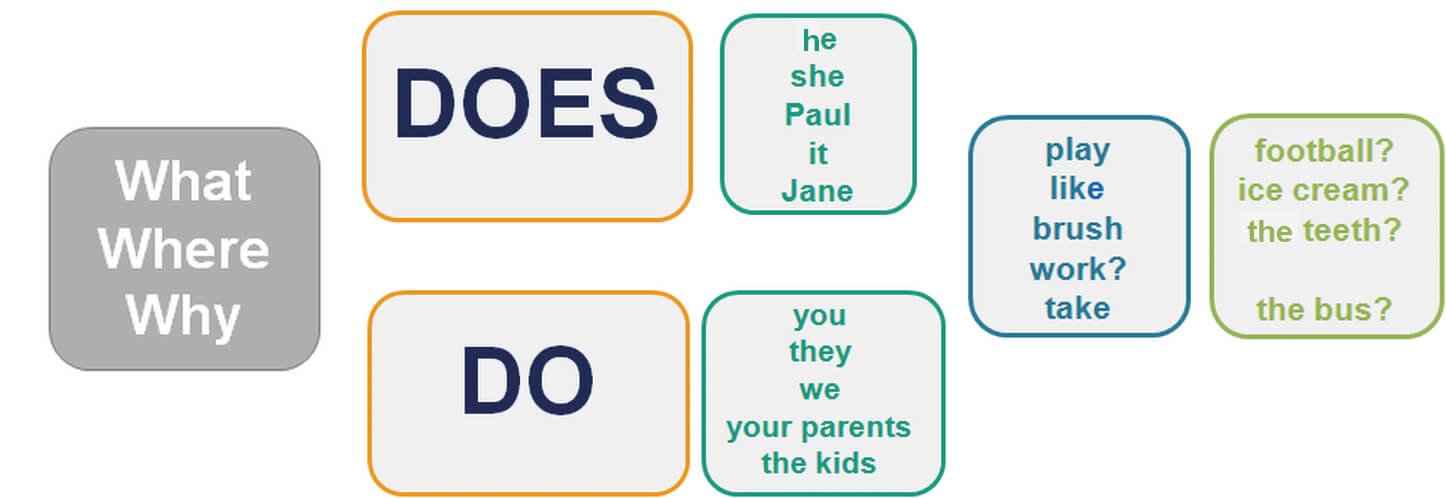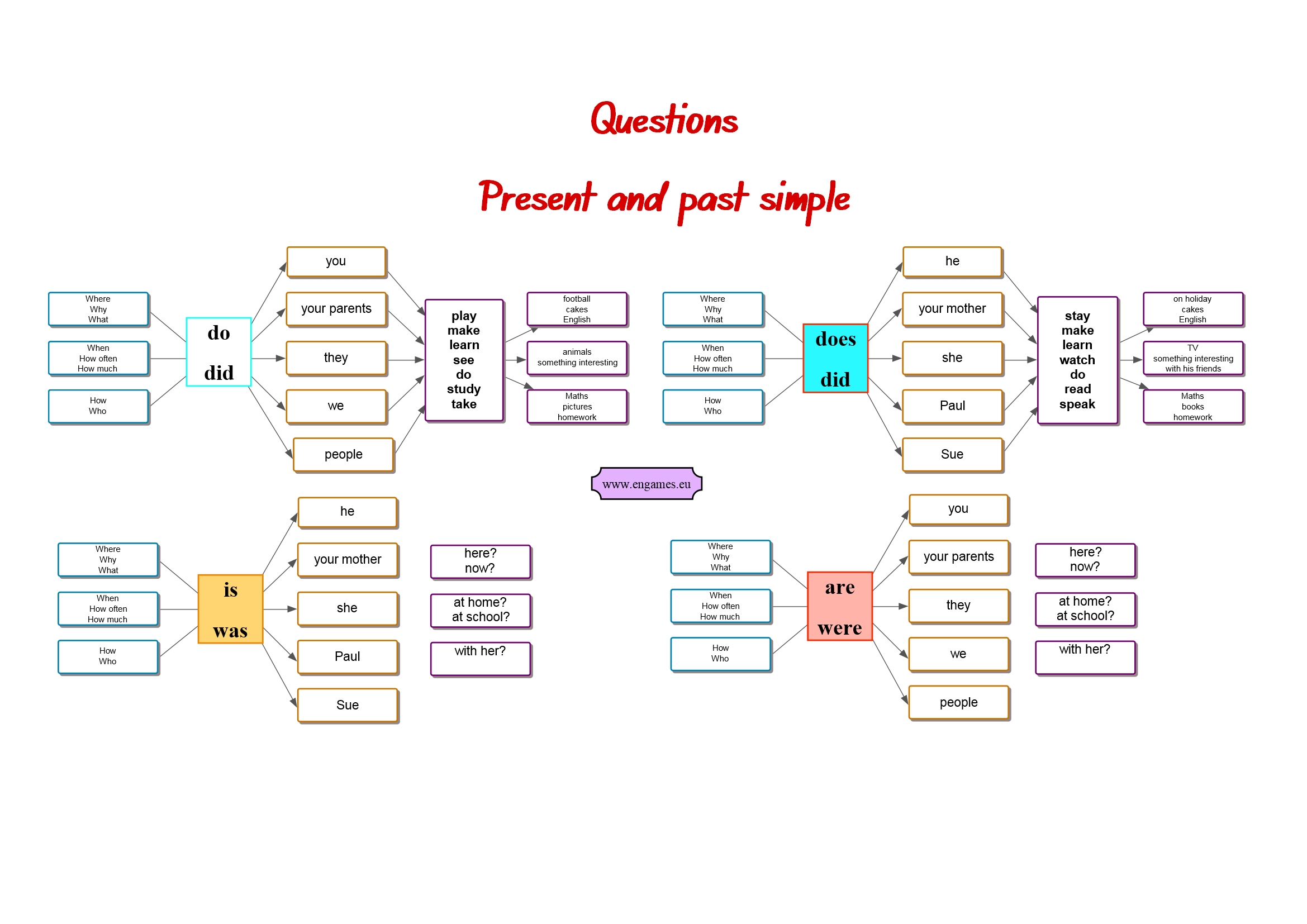Once elementary students master forming questions in the present simple tense, their communicative ability grows by hundreds of percent. Students then can ask nearly about anything, and all of a sudden they can communicate meaningfully. However, for many teachers the questions are a nightmare because only a few students do really learn to form the questions.
To help you and your students I will share a set of activities I have used and which worked really well in my classes. In this post you can find an infographic, a video drill, a speaking activity, two games and an online quiz.
Questions in present simple tense – infographic
Start the lesson by explaining the grammar. I use the following infographic to explain the way in which questions are formed.
ADVERT:
[showmyads]
Remind your students that the word order in English is given (SVOMPT) and that they have to follow it. To form a question they need to add the words DO or DOES at the beginning and a question mark at the end.

To form the short answers students have to start with YES or NO, the pronoun representing the subject from the question and DO, DOES, DON’T or DOESN’T. You can tell your students that the word which was at the beginning of the question appears at the end of the answer.
You can see my explanation of the process in the following video:
The following quiz can help your students practise the short answers either at school or at home. The quiz consists of two parts. In the first part, students should match the questions and answers. In the second part, students have to write the short answers. The students will be rewarded with a game after each part of the quiz they pass. The quiz is in HTML5, so it will play on all desktops and mobile devices.
Questions in present simple tense – speaking activity
In the following activity students should work in pairs or in small groups of three or four. Print the worksheet once for each pair or group.
ADVERT:
[showmyads]
One of the students chooses a picture and the others form questions about the pictures. Their task is to ask YES/NO questions in such a way to find out which picture their partner is thinking about.
Questions in present simple tense – question words
Before you move to questions starting with the question words, it is a must that students know, and are able to produce, the question words.
Start with the following drill. On the first slide students listen and repeat the words. From the second slide on, they have to produce the question words before the native speaker says them. Play the video at least twice.
Now, hand out the following worksheet and ask the students to complete the first exercise with the question words
Questions in present simple tense – WH questions
Now explain that WH questions are formed by adding the WH words at the beginning of the question. You can explain it using the infographic below:

Questions in present simple tense – games
Use the following games to practise the grammar your students learnt.
The first game is called Penalty Shootout. In this game you should choose the correct question and then try to score a goal. Good luck.
As the game is in Flash, it will only play on desktop computers.
Present simple questions – Penalty Shoot out
The second game is in Flash too, and it will play only on desktop computers. It is called En Garde, and your task is to choose the correct option and then stop the circle as close to the centre of the target as possible. Enjoy.
Asking questions is one of the most important functions of a language. Making questions in English is quite easy, but students still need to understand the basics. I have tried to put all the basic rules into a mind map. Then I have come up with a story about question formation and several games to practice the grammar. I hope that now the students will be able to form the questions correctly.
Questions – Mind map
Display or print out the following mind map for all the students and explain that each question can start with a WH word followed by DO, DOES or DID. It might be a good idea to ask the students to name or describe the columns in their own words.
ADVERT:
[showmyads]

Explaining grammar using the words like auxiliary, verb and subject might be a precise description of the grammar but it is very hard for students to understand. Moreover, people remember stories better than any explanation. And that is why I have created the following story to help my students use the auxiliaries correctly:
Once upon a time there was a land called Trainglish (train and English). And there were only SVOMPT trains with affirmative sentences. And in these trains V cars were the most important and most beautiful ones.
But one day the Great Constructor created an auxiliary train “DO”. But the “DO” car did not want to be just an ordinary train. He was very proud and selfish and he wanted to be the most important train in the world. So he started QUESTION trains. And as he was so big-headed he had to ride at the beginning of these trains. And as the other cars did not protest, he wanted more.
First he brought his family DOES and DID. Then he brought WH cars and they all drove at the beginning of each Question train. But it was not enough for him. He still wanted more. And thus he decided that no car can be more handsome than he.
“All the other cars have to be simple,” he announced. And that is why the V car lost all its endings and forms and it has be only in a simple form in Question Trains.
“And all the verbs agreed?”
“No, there was one that refused. It was the BE car. And ever since WAS, IS, ARE and WERE cars ride at the beginning of their Question trains. They allow only WH cars to join them.”
Questions – Quizzes and games
There are three quizzes and games to help the students remember the grammar. In the first HTML5 quiz you should put the words into the correct order to create questions. At the end of the quiz there is the game called Angry Finches.
Questions – Present simple and past simple
The second quiz is again in HTML5. However this time, your task is to write the question to ask about the missing information. At the end of the quiz there is the game called Tower Defence.
Advert:
[showmyadsa]
The last game is in Flash and therefore it will play only on your desktop. You have to choose the correct option and then you should hit your opponent. Good luck.



